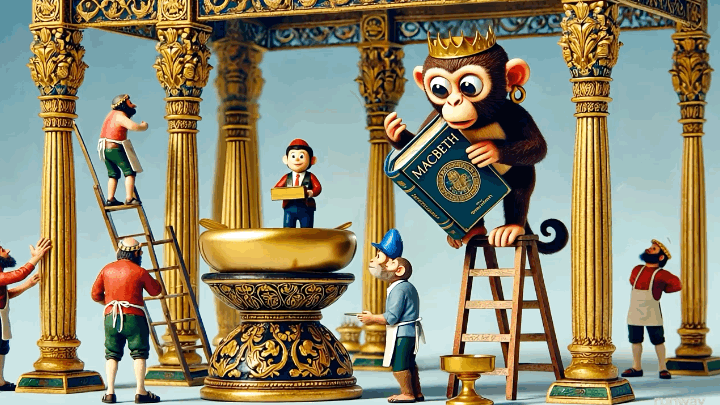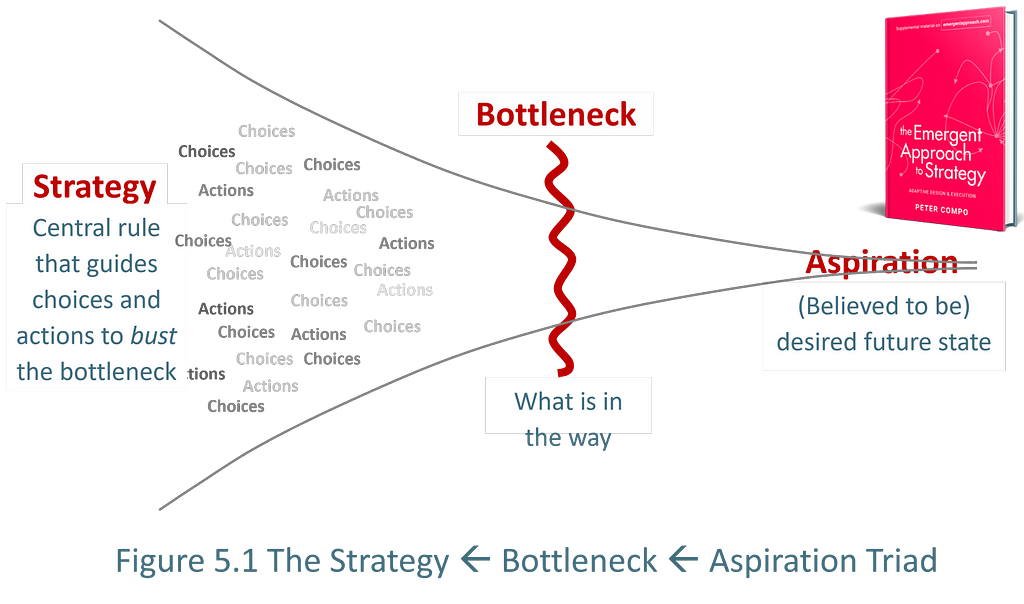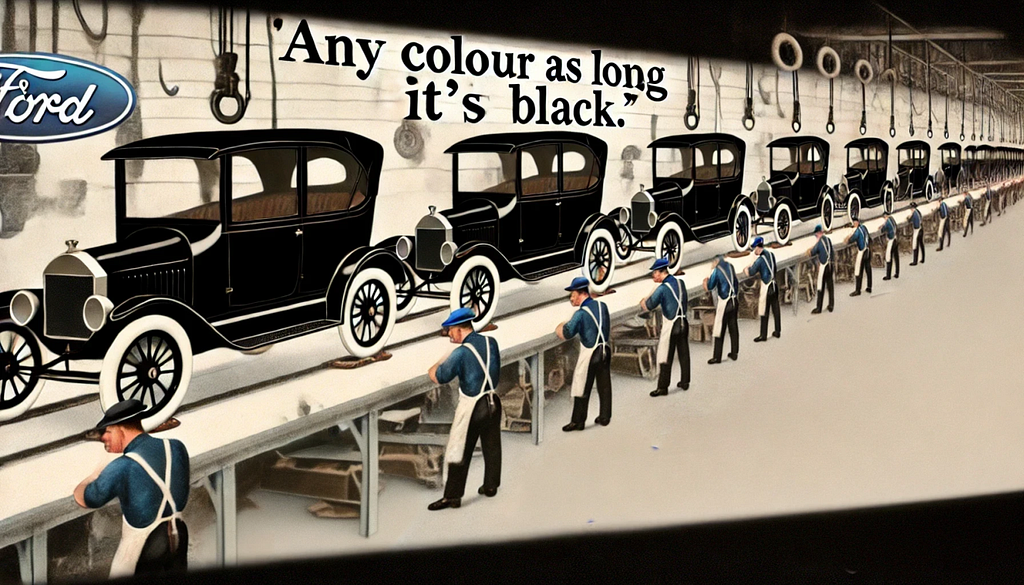“Whenever smart and well-intentioned people avoid confronting obstacles, they disempower employees and undermine change.”― John Kotter
“Since the strength of the chain is determined by the weakest link, then the first step to improve an organisation must be to identify the weakest link.”― Eliyahu Goldratt
[TL;DR In the world of strategy and innovation, the key to success lies in focusing on bottlenecks rather than being distracted by quick wins. Astro Teller’s metaphor of “tackling the monkey” highlights the importance of addressing the hardest part of a problem first. Research from Northwestern University shows how the allure of easy tasks can create a false sense of progress. The Strategy-Bottleneck-Aspiration triad offers a framework for focusing on the most critical constraints, while rules and constraints serve as enablers of creativity, guiding organisations toward meaningful innovation. Henry Ford’s relentless focus on standardisation exemplifies how busting bottlenecks can lead to success. Ultimately, constraints drive focus and creativity, turning challenges into opportunities for growth.]
The Pedestal Problem and Tackling the Monkey

Astro Teller, “Captain of Moonshots” at X, the moonshot factory (formerly Google X), popularised a critical concept in innovation: focus on the hardest part of the problem first. He uses the metaphor of “teaching a monkey to recite Shakespeare” to illustrate this point. While it might seem easier to focus on building the pedestal for the monkey to stand on, the real challenge lies in training the monkey — this is where progress truly happens.
Teller’s metaphor warns against spending time on the simpler, more comfortable tasks just to feel productive. The pedestal may offer a sense of accomplishment, but it’s the wrong focus. Real innovation requires confronting the hardest part of a problem first. As Teller says, “Don’t use up all your resources on the easy stuff”.
False Progress and Easy Wins
Research from Maryam Kouchaki at Northwestern University — Kellogg School of Management underscores the dangers of over focusing on simple tasks. In high-pressure environments, people often gravitate toward simpler tasks to feel a sense of progress. While tackling effortless tasks (pedestals) — like answering emails or filing paperwork — may provide short-term relief, it can also create a false sense of productivity. The research shows that when workloads increase, individuals are 8% more likely to choose easier tasks, which boosts immediate output but hampers long-term performance and growth.

In the study, doctors in an emergency room, under heavy workloads, often chose less complex cases to manage their fatigue and workload. While this made them feel more productive in the moment, the research revealed that doctors who consistently took on harder cases improved their skills more effectively over time and generated greater value for the hospital.

This tendency to focus on easier tasks, while offering temporary relief, ultimately stunts growth and innovation — emphasising the importance of focusing on the most critical obstacles, or bottlenecks, to truly achieve progress. Peter Compo’s powerful technique of the Strategy-Bottleneck-Aspiration triad is what we will discuss next.
Strategy-Bottleneck-Aspiration: A Triad for Success

“Deriving strategy from bottlenecks keeps you from thinking everything matters. If everything matters, then nothing matters.” — Peter Compo
Successful strategy doesn’t begin with lofty goals or aspirations — it starts with the constraints that stand in the way. This is where the Strategy-Bottleneck-Aspiration triad comes into play:
- Aspiration: Define the future state or goal you want to achieve.
- Bottleneck: Identify the primary constraint or obstacle preventing you from reaching that aspiration.
- Strategy: Develop a focused central rule aimed at overcoming that bottleneck.
This triad ensures that all decisions and actions align with the goal of overcoming the most critical challenge. Peter Compo captures this perfectly: “A strategy is the central rule of a framework designed to unify all decisions and actions around busting the bottleneck to achieving aspirations.” In this model, strategy becomes a real-time guide for breaking through obstacles, not just a static plan.
The key is to work backwards from the aspiration, identifying the bottleneck first and designing the strategy to solve that problem (Figure 5.1 above). This prevents organisations from getting lost in wishful thinking or superficial progress.
At first glance, rules may seem to stifle creativity, but in reality, they are powerful enablers of innovation. Rumelt likens strategy rules to guardrails on a highway: “Like the guardrails on a highway, the guiding policy directs and constrains action without fully defining its content.” These rules provide a framework within which creativity can flourish.
“Rules lead to patterns. If followed, the strategy rule works in an integrated way with the other components of the framework to drive change and innovations,” Rumelt explains. The real-time guidance provided by these rules allows for focused decision-making without over-constraining teams. The paradox is that constraints, far from limiting innovation, actually enable it by creating focus.
In our conversation on The Innovation Show, Peter Compo shared that legendary jazz musician Charlie Parker once said, “Learn your horn. Learn the changes. Then forget them and just wail.” This “Parker Principle” directly applies to strategy. Once you internalize the rules, they provide the structure necessary for creative freedom and improvisation. Rules enable agility because they channel efforts into the most important areas — busting the bottleneck.
Henry Ford’s Strategic Mastery: Busting the Bottleneck of Standardisation

One of the most famous examples of focusing on bottlenecks comes from Henry Ford. In the early 20th century, highly skilled workers handcrafted automobiles. As a result, they were expensive and slow to produce. Ford identified this lack of standardisation as the bottleneck preventing mass production and affordable pricing. His strategy focused on eliminating this constraint, and his guiding rule was simple: “Never sacrifice throughput or cost for style or options.”
By introducing the assembly line, Ford decimated production time and costs, making cars accessible to the average person. The Model T, famously available in “any colour as long as it’s black,” resulted from Ford’s relentless focus on efficiency over aesthetics. Ford built his strategy around overcoming the bottleneck of standardization, and by sticking to his guiding rules, he revolutionized the automotive industry.
Ford’s success illustrates the Strategy-Bottleneck-Aspiration triad in action: he defined his aspiration (mass production of affordable cars), identified the bottleneck (lack of standardisation), and designed his assembly lines and standardised parts as guided by his strategy to overcome the constraint. By adhering to his guardrails, Ford achieved his goals and transformed the industry.
Constraints as the Heart of Creativity

Creativity thrives under constraints. This may seem counterintuitive, but as artists and innovators know, limitations are often the catalyst for breakthroughs. As Henri Matisse famously said, “There is nothing more difficult for a truly creative painter than to paint a rose, because before he can do so he has to first forget all the roses that were ever painted before.”
In business, the same principle applies: constraints force teams to focus on the critical problems, creating an environment where real innovation can occur. When there are no constraints, everything seems like a good idea, and we lose focus. Rules and constraints, far from stifling creativity, enable it by narrowing the range of possibilities and guiding efforts toward overcoming bottlenecks.
Without a bottleneck to solve, there’s no real challenge — just a series of arbitrary choices. It’s the constraints that make strategy meaningful, pushing teams to innovate within a clear framework.
Ultimately, constraints are the heart of creativity. They focus our efforts, drive innovation, and turn challenges into opportunities. By embracing bottlenecks and designing strategies to overcome them, individuals and organisations alike can unlock their full potential, achieving their aspirations through disciplined, focused action.
So, as you move forward, it is wise to ask yourself — will you embrace the constraints that spark true innovation, will you tackle the monkey, or will you settle for the illusion of progress and paint the pedestal?
The latest episode of our 6-part series with Peter Compo drops tomorrow morning. I am currently reading the classic “Competing For The Future” with our forthcoming guest, Gary Hamel .
https://medium.com/media/a97ad1fe3730170b548b1046ef912643/href
Tackling the Monkey: Addressing the Bottleneck for Strategic Success was originally published in The Thursday Thought on Medium, where people are continuing the conversation by highlighting and responding to this story.